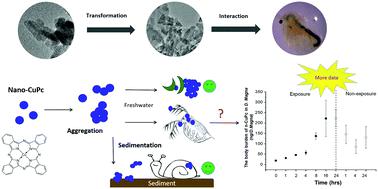当前位置:
X-MOL 学术
›
Environ. Sci.: Nano
›
论文详情
Our official English website, www.x-mol.net, welcomes your feedback! (Note: you will need to create a separate account there.)
A “point-of-entry” bioaccumulation study of nanoscale pigment copper phthalocyanine in aquatic organisms
Environmental Science: Nano ( IF 7.3 ) Pub Date : 2021-1-13 , DOI: 10.1039/d0en00705f Chengfang Pang 1, 2, 3, 4 , Lars M. Skjolding 1, 2, 3, 4 , Henriette Selck 4, 5, 6 , Anders Baun 1, 2, 3, 4
Environmental Science: Nano ( IF 7.3 ) Pub Date : 2021-1-13 , DOI: 10.1039/d0en00705f Chengfang Pang 1, 2, 3, 4 , Lars M. Skjolding 1, 2, 3, 4 , Henriette Selck 4, 5, 6 , Anders Baun 1, 2, 3, 4
Affiliation

|
Nanoscale pigments (e.g., nanoscale copper phthalocyanine; nano-CuPc) are used in very large quantities on a global scale. Due to their widespread use, they may reach the aquatic environment and potentially cause environmental harm. While some focus has been on the ecotoxicity of nanopigments, studies of their bioaccumulation behaviour are still rare. To address this knowledge gap, we examined nano-CuPc bioaccumulation potential in lower trophic-level aquatic organisms exposed via both water and sediment: algae (Raphidocelis subcapitata), crustaceans (Daphnia magna) and snails (Potamopyrgus antipodarum). For the first time attachment of nano-CuPc to algae was quantified by single-cell-ICP-MS analysis after 48 hours incubation: nano-CuPc was attached to approximately 10% of the cells in the algal population. For D. magna a relatively slow uptake rate of 12.8 ng nano-CuPc per daphnia per h was found during the first 4 hours, and the rate shifted to 82.7 ng nano-CuPc per daphnia per h from 4 to 16 hours. Nano-CuPc was not found to be depurated significantly from D. magna within 24 hours in clean medium. This lack of depuration in D. magna calls for further studies with longer depuration periods to identify whether nano-CuPc accumulated in the gut epithelia or remained retained in the gut and if presence of food caused alterations. For the freshwater snail, P. antipodarum, no significant nano-CuPc concentrations were associated with tissues, shells, or total snails (i.e., tissue plus shell) after sediment nano-CuPc exposure. This is important, as our results support the finding that nano-CuPC can only be weakly dispersed in water and that sediments can be expected to be the major sink. Overall, our study showed a low bioaccumulation potential of nano-CuPc in the studied freshwater organisms suggesting a low bioavailability of sediment-associated nano-CuPc and, thus, a limited entry from sediment into the benthic food web.
中文翻译:

纳米颜料铜酞菁在水生生物中的“进入点”生物富集研究
纳米级颜料(例如,纳米级酞菁铜;纳米CuPc)在全球范围内大量使用。由于它们的广泛使用,它们可能会到达水生环境,并可能对环境造成危害。尽管一些关注点集中在纳米色素的生态毒性上,但对其生物积累行为的研究仍然很少。为了解决这一知识鸿沟,我们研究了通过水和沉积物暴露的低营养级水生生物的纳米CuPc生物富集潜力:藻类(Raphidocelis subcapitata),甲壳类动物(Daphnia magna)和蜗牛(Potamopyrgus antipodarum))。首次孵育48小时后,通过单细胞ICP-MS分析定量了纳米CuPc与藻类的附着:纳米CuPc与藻类种群中约10%的细胞附着。对于D. magna,在最初的4小时内发现相对较慢的摄取速率为每小时每水蚤12.8 ng纳米CuPc,并且吸收速率从4到16小时转变为每小时每水蚤82.7 ng纳米CuPc。在干净的培养基中,未发现24小时内可以从D. magna大量纯化Nano-CuPc 。D. magna缺乏纯净度,因此需要进行更长的净化时间的进一步研究,以鉴定纳米CuPc是积累在肠道上皮中还是保留在肠道中,以及食物的存在是否引起了变化。对于淡水蜗牛,P. antipodarum,沉积物纳米CuPc暴露后,没有明显的纳米CuPc浓度与组织,贝壳或总蜗牛(即组织加贝壳)相关。这很重要,因为我们的结果支持了以下发现:纳米CuPC只能微弱地分散在水中,而沉积物可能是主要的汇。总体而言,我们的研究表明,纳米CuPc在所研究的淡水生物中具有较低的生物富集潜力,这表明与沉积物相关的纳米CuPc的生物利用度较低,因此从沉积物中进入底栖食物网的机会有限。
更新日期:2021-02-01
中文翻译:

纳米颜料铜酞菁在水生生物中的“进入点”生物富集研究
纳米级颜料(例如,纳米级酞菁铜;纳米CuPc)在全球范围内大量使用。由于它们的广泛使用,它们可能会到达水生环境,并可能对环境造成危害。尽管一些关注点集中在纳米色素的生态毒性上,但对其生物积累行为的研究仍然很少。为了解决这一知识鸿沟,我们研究了通过水和沉积物暴露的低营养级水生生物的纳米CuPc生物富集潜力:藻类(Raphidocelis subcapitata),甲壳类动物(Daphnia magna)和蜗牛(Potamopyrgus antipodarum))。首次孵育48小时后,通过单细胞ICP-MS分析定量了纳米CuPc与藻类的附着:纳米CuPc与藻类种群中约10%的细胞附着。对于D. magna,在最初的4小时内发现相对较慢的摄取速率为每小时每水蚤12.8 ng纳米CuPc,并且吸收速率从4到16小时转变为每小时每水蚤82.7 ng纳米CuPc。在干净的培养基中,未发现24小时内可以从D. magna大量纯化Nano-CuPc 。D. magna缺乏纯净度,因此需要进行更长的净化时间的进一步研究,以鉴定纳米CuPc是积累在肠道上皮中还是保留在肠道中,以及食物的存在是否引起了变化。对于淡水蜗牛,P. antipodarum,沉积物纳米CuPc暴露后,没有明显的纳米CuPc浓度与组织,贝壳或总蜗牛(即组织加贝壳)相关。这很重要,因为我们的结果支持了以下发现:纳米CuPC只能微弱地分散在水中,而沉积物可能是主要的汇。总体而言,我们的研究表明,纳米CuPc在所研究的淡水生物中具有较低的生物富集潜力,这表明与沉积物相关的纳米CuPc的生物利用度较低,因此从沉积物中进入底栖食物网的机会有限。

























 京公网安备 11010802027423号
京公网安备 11010802027423号